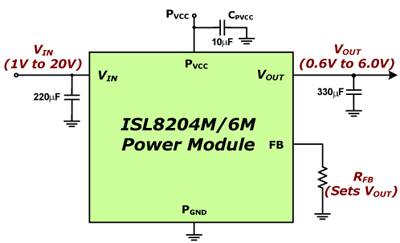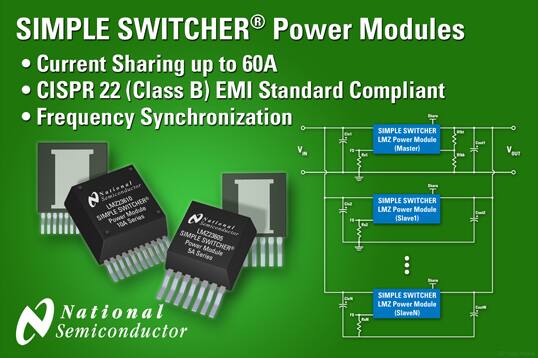Integrated Point-of-Load Power Modules Offer a Complete Solution with Scalability
投稿人:电子产品
2012-02-28
Today, distributed power architecture has evolved into intermediate bus architecture (IBA), which provides the required bus voltage to power a variety of DC/DC converters used on system boards of datacom/telecom equipment, servers and PCs. These DC/DC converters serve as point-of-load (POL) voltage regulators and provide the required step-down voltage to power a variety of loads like microprocessors, DSPs, memories, logic and other devices found on these boards
Designing POL voltage regulators with discrete components is cumbersome, time-consuming, inefficient, and takes up more space. To make life easy for designers and to give them more time for other system needs, manufacturers such as Intersil, International Rectifier, Texas Instruments and others, have developed highly integrated POL modules that offer complete DC/DC converter solutions with scalability to satisfy a wide range of POL power requirements. Hence, an upgrade to the next level of power requirement means simply choosing a pin-for-pin compatible, higher-performance member of the integrated POL family without changing the circuit board.
Take, for example, Intersil’s ISL820xM series, which is a highly integrated 20 V input and variable output step-down point-of-load (POL) DC/DC converter family with pin-for-pin compatible members. The integrated ISL820xM modules include a high-performance PWM controller, power MOSFETs, an inductor, and most of the passive components required to complete a DC/DC power supply. All these components are packed in a single 15 x 15 mm QFN package. Switching at 600 kHz, the ISL820xM’s output current capability goes from 4 to 10 A. While the ISL8201M is a 20 V, 10 A output-current model, the ISL8204M and the ISL8206M are 4 and 6 A pin-compatible versions, respectively.
The pin-compatible common footprint makes it easy for a designer to migrate from one module to another without changing the PC-board layout. Hence, when a design has to scale from lower current to higher output current, a designer can simply remove the old part and replace it with a higher-current member, without any circuit changes, to reduce time to market.
Thus, one simple layout fits all members of this module family. However, to create a complete high-current solution on the board at the POL, it requires bulk input and output capacitors and one resistor to program the output voltage from 0.6 to 6.0 V (Figure 1). Using voltage-mode control, the output voltage can be precisely regulated to as low as 0.6 V with up to ±1 percent output voltage regulation. The ISL8201M also features internal compensation, internal soft-start, auto-recovery overcurrent protection, an enable option, and pre-biased output.

Figure 1: To complete the DC/DC converter design, the integrated point-of-load (POL) module requires only bulk input and output capacitors and one resistor to program the output voltage.
Scalable POL modules
Another supplier to offer integrated POL DC/DC voltage regulators as complete solutions for energy-efficient server, storage, telecom, netcom and set-top box applications is International Rectifier. The supplier’s SupIRBuck integrated POL regulators come in compact 4 x 5 mm packages to offer the same efficiency and functionality as previous generation devices, but in a 33 percent smaller footprint. The pin and footprint compatible IR3853/56/59 SupIRBuck voltage regulators also integrate a high-performance controller with latest generation MOSFETs, as well as an inductor in a slim 4 x 5 mm PQFN package. Optimized for 12 V input, IR3853/56/59 deliver 4, 6, and 9 A output currents, respectively. Offering more than 96 percent peak efficiency, the output voltage varies from 0.7 V to 90 percent Vin. According to IR, the common footprint of the devices provides design flexibility and allows cut-and-paste layout for fast time to market.
By encapsulating all the semiconductor and passive components, including magnetics, inside one single compact package, modules have been pushing the power density of non-isolated POL DC/DC converters to new heights. A good example of this trend is the TI (ex-National Semiconductor) LMZ series of Simple Switcher power modules. Integrating switching controller, power FETs and an inductor with other passives in one standard semiconductor chip package, TI/National continues to expand the line by adding new members with higher output current capability, while keeping the package format same.
The LMZ2-series power modules (e.g. LMZ22003, LMZ23603) are pin and form compatible with LMZ1 series and offer output currents up to 10 A with additional features for powering high-current intermediate rails, FPGAs, and noise sensitive applications (the preface LMZ indicates that this is a module product). They also feature a frequency synchronization pin that controls the switching frequency of the internal circuitry, and a current sharing pin for paralleling multiple power modules together for achieving up to 60 A of output current (Figure 2). With an integrated shielded inductor inside the package, the LMZ2-series power modules are compliant with the CISPR 22 (Class B) radiated and conducted emissions standard to ensure easy PC-board design. The 10-A Simple Switcher modules are designed to operate up to an ambient temperature of 70°C with zero air flow.

Figure 2: For higher output currents, the LMZ2xxxx series Simple Switcher modules can be easily paralleled.
All Simple Switcher modules are supported by the company’s online design tool Webench. By feeding a few performance parameters into a software tool, engineers can select the right part for their application, as well as provide the values for few external passives needed to complete the design on the board. You can find a wide variety of Webench Buildit boards on the DigiKey website.
POL power module families provide a ready-to-design solution that integrates all the passive components required for a complete DC/DC power solution. The products within a given family are usually footprint compatible giving designers the flexibility to fix their POL power requirements later in the design cycle and to optimize system power needs without having to rework the PCB. For more information, use the links provided to access product pages on the DigiKey website.
免责声明:各个作者和/或论坛参与者在本网站发表的观点、看法和意见不代表 DigiKey 的观点、看法和意见,也不代表 DigiKey 官方政策。








